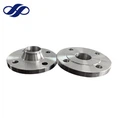The 316L Steel Flange: A Comprehensive Overview
A flange is a crucial component in piping systems, used to connect sections of pipe or other components, such as valves and pumps, in a pipeline. Flanges are designed to provide support, stability, and ease of installation and maintenance. The type of flange used depends on the conditions of the application, such as pressure, temperature, and fluid characteristics. In the industrial and marine industries, stainless steel flanges are widely used, and 316L steel is one of the most popular choices.
316L steel, also known as 1.4404, is a low-carbon austenitic stainless steel with high resistance to corrosion and pitting. It is widely used in applications where exposure to corrosive substances is a concern, such as chemical processing, petrochemical, and food and beverage industries. The “L” designation indicates that the carbon content in this steel is low, making it suitable for use in applications where welding is necessary.
The properties of 316L steel flanges make it ideal for use in demanding applications, including high pressure and high temperature operations. The high resistance to corrosion in harsh environments is a key advantage of 316L steel. This material is also highly resistant to pitting and crevice corrosion, making it suitable for use in chloride-containing environments, such as seawater and saltwater. In addition, 316L steel is non-magnetic, making it ideal for use in applications where magnetic interference is a concern.
The manufacturing process of 316L steel flanges is also an important factor to consider. This material is typically produced through a hot forging process, followed by heat treatment to enhance its mechanical properties. The finished product is tested for quality, ensuring that it meets the required standards and specifications for strength, toughness, and dimensional accuracy.
In terms of design, 316L steel flanges are available in a wide range of configurations, including slip-on, weld-neck, and threaded flanges. The design of the flange, including its thickness and the type of face finish, will depend on the conditions of the application, such as the pressure and temperature ratings. The standard sizes for 316L steel flanges range from 1/2” to 24”, and custom sizes can be manufactured to meet specific requirements.
In conclusion, 316L steel flanges are an excellent choice for demanding applications in industries such as chemical processing, petrochemical, and food and beverage, where exposure to corrosive substances is a concern. The high resistance to corrosion, combined with the low carbon content, makes 316L steel flanges suitable for use in welding applications, while the non-magnetic properties make it ideal for use in environments where magnetic interference is a concern. The wide range of configurations and design options, along with the rigorous quality control measures, ensure that 316L steel flanges are a reliable and durable component in any piping system.





